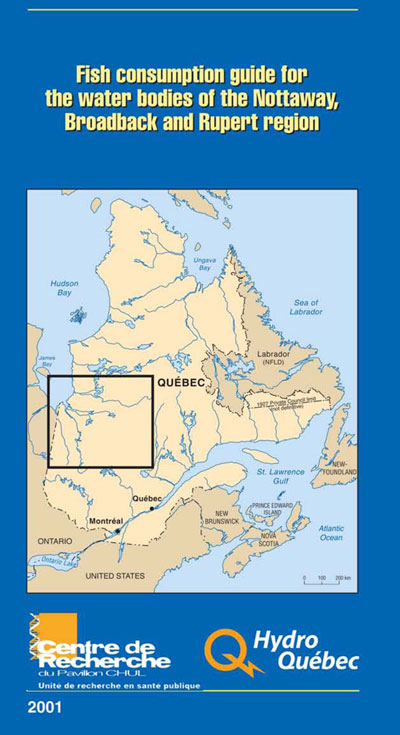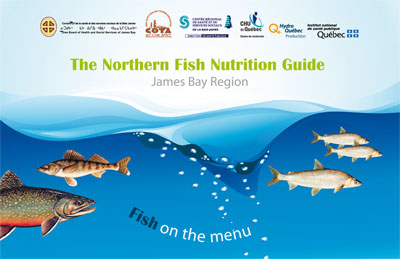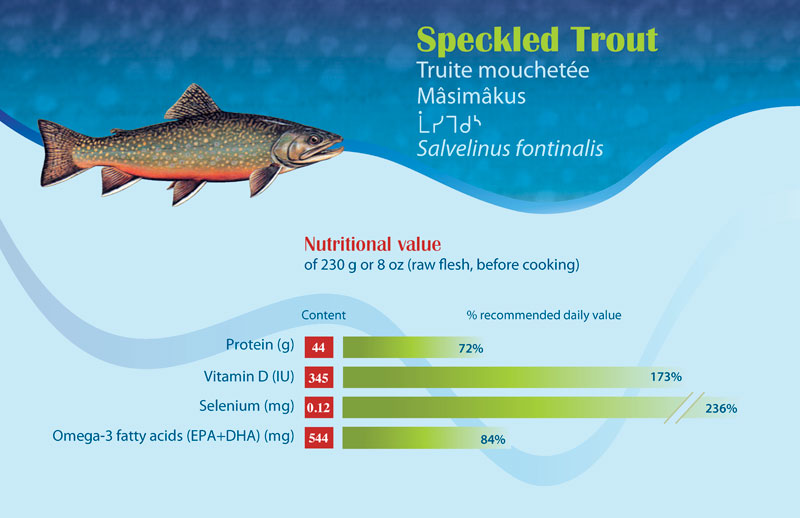Hydro-Québec and the mercury issue
The impoundment of hydroelectric reservoirs leads to the conversion and circulation, in the aquatic environment, of mercury already present in plants and flooded soil. The result is an increase in fish mercury levels for a period ranging from 10 to 35 years, depending on the fish species and reservoir characteristics. From the early 1980s until about 2010, Hydro-Québec conducted an extensive research program designed, on the one hand, to determine the effects of the increase in mercury on fish, birds and mammals, and on the other hand, to manage the potential risk to the health of fish consumers.
The program’s specific objectives were the following:
- Study the fate of mercury in natural and modified environments in Northern Québec.
- Determine the effects of increased fish mercury levels on wildlife.
- Examine the health risks and benefits of fish consumption.
- Improve the methods of predicting the impacts of hydroelectric projects.
- Search for ways to mitigate the increase in fish mercury levels caused by reservoir impoundment.
The results obtained from this program show that mercury levels in modified environments are not harmful to populations of fish, birds and mammals that eat fish. The recent monitoring of fish mercury levels in hydroelectric developments and of the peripheral population’s exposure to mercury have shown that, at the levels of mercury observed in Québec’s reservoirs, the health benefits of eating fish far outweigh the mercury-related risks. Hydro-Québec is now focusing its efforts on developing, in close collaboration with regional public health authorities, consumption guides which will allow recreational anglers and subsistence fishermen to continue to benefit from the great nutritional value of fish while avoiding mercury-related risks.
Video: How are fish mercury levels monitored?
Example of the Eastmain-Sarcelle-Rupert complex: In the areas affected by the partial diversion of the Rupert, a team follows the evolution of fish mercury levels. In light of the results, we produce a fish consumption guide in collaboration with the Cree Board of Health and Social Services of James Bay to promote the benefits of healthy fish consumption to Crees.
Mercury in hydroelectric reservoirs
Mercury sources
Mercury is found everywhere in the environment. It is in the air, soil and vegetation, as well as in lakes and rivers. It can be released into the air naturally, by volcanoes and forest fires, or as a result of human activities such as coal burning and waste incineration. In the Nord-du-Québec region, it is carried through the atmosphere over long distances, and falls into lakes and forests with dust particles and rain. Mercury that is present mainly in inorganic form is relatively harmless, because it is not readily assimilated by living beings.

Mercury and fish consumption
For most people, the main source of mercury exposure is fish consumption. Methylmercury (or organic mercury) is readily absorbed by the human digestive system. It is then carried through the blood to all organs in the body. The highest concentrations are found in the liver, kidneys and brain. It takes from 50 to 70 days to eliminate half the methylmercury ingested. During pregnancy, methylmercury present in the mother's blood passes through the placenta and into the bloodstream of the unborn child.

Research and agreements on mercury
An unknown phenomenon
In the 1970s, at the time of preliminary work for the impoundment of Robert-Bourassa reservoir (the first reservoir in the La Grande complex; impoundment was completed in 1979), the temporary increase in mercury levels in reservoirs was an unknown phenomenon. As well, knowledge on the fate of mercury in natural aquatic environments was very incomplete.
In conjunction with the La Grande complex Environmental Monitoring Network (EMN), fish mercury levels in the region's lakes were measured before, during and after reservoir impoundment. As soon as the EMN findings revealed a significant increase in fish mercury levels, Hydro-Québec developed a research program to shed light on the mechanisms responsible for this phenomenon and determine the risks to the health of not only fish, birds and piscivorous mammals, but also of recreational anglers and subsistence fishermen.
Research partnerships
To carry out its research program, Hydro-Québec secured the cooperation of a number of partners:
- the Environmental Research Chair set up by Hydro-Québec, the Natural Sciences and Engineering Research Council of Canada and the Université du Québec à Montréal to study the fate of mercury in natural and modified environments in the Nord-du-Québec region
- the Université de Sherbrooke, for studies on modeling mercury in fish in hydroelectric reservoirs
- the Université de Montréal's Faculty of Veterinary Medicine, for a clinical study on the effects of mercury exposure on mink
- the Canadian Wildlife Service, for a study on the effects of mercury on the reproductive success of osprey
- Fisheries and Oceans Canada's Freshwater Institute, for a study of the rate of mercury methylation in experimental reservoirs
- the public health research institute at CHUL, Université Laval's hospital centre, to produce fish consumption guides
- the Cree Board of Health and Social Services of James Bay, to produce a fish nutrition guide for the Baie-James region
These various partnerships have allowed Hydro-Québec to gain an in-depth understanding of the issue of mercury in hydroelectric reservoirs and to remain on the leading edge of research on this topic.
From acquiring knowledge to managing the potential health risk to fish consumers
From 1978 to 1985, Hydro-Québec's mercury-related activities were intended mainly to monitor the changes in fish mercury levels in the La Grande complex reservoirs and conduct complementary studies in order to understand the phenomena revealed by the monitoring.
From 1986 to 1988, Hydro-Québec's research activities were carried out in accordance with the Mercury Agreement (1986), as described below (see Mercury agreements).
From 1988 to 2010, Hydro-Québec established a corporate mercury research program at the same time as it continued its activities related to the mercury agreements (1986 and 2001). The object of this program was to meet Hydro-Québec needs that were not priorities for the other partners to these agreements.


The main activities included in the program were the following:
- monitoring of fish mercury levels in the La Grande complex
- modeling of mercury levels in fish of future reservoirs
- determination of the risk to populations of birds and piscivorous mammals
- determination of the risks and health benefits associated with fish consumption
- search for mitigation measures that reduce the increase in fish mercury levels in recently flooded reservoirs
To find out more
To find out more about the lessons learned from these partnerships, you may consult the monograph produced through an initiative of the Hydro-Québec–NSERC–UQAM (Lucotte, M., R. Schetagne, N. Thérien, and A. Tremblay. 1999. Mercury in the Biogeochemical Cycle: Natural Environments and Hydroelectric Reservoirs of Northern Québec (Canada). New York, Springer. 334 p).
A monograph on mercury
This publication is a compilation of 14 scientific articles. The articles cover a variety of subjects, including the increase in mercury levels in lake sediments following atmospheric deposits of anthropogenic origin, the mechanisms responsible for mercury methylation and transfer to the food chain in reservoirs, the reasons why the increase in fish mercury levels is temporary and the risks to wildlife such as mink and osprey.

Hydro-Québec's current activities related to the mercury issue
A research program to manage the potential health risk to fish consumers
Through the implementation of the corporate research program, Hydro-Québec and its partners were able to establish the extent, duration and main mechanisms responsible for the increase in fish mercury levels in new reservoirs. The program also showed that this increase does not endanger populations of fish, birds or mammals that eat fish. Therefore, Hydro-Québec's current activities related to mercury are focused on providing recreational anglers and subsistence fishermen with accurate information on the potential health risk associated with the consumption of fish caught in newly impounded reservoirs.
The activities under way are mainly related to Hydro-Québec's commitments and obligations described in the government authorization certificates for recent hydroelectric developments. They include the following elements:
- regular monitoring of mercury levels in reservoir fish;
- improvement of models for predicting fish mercury levels in reservoirs planned by the company;
- development of methods for analyzing the health risk for consumers posed by the temporary increase in fish mercury levels;
- technical support to public health authorities in the regions that host Hydro-Québec's facilities (e.g. calculating the number of meals per month for each species of fish, from each developed environment, that can be consumed without exceeding the recommended exposure level to avoid any mercury-related health risk);
- development, assessment and improvement of tools to provide the public with adequate information on the potential mercury-related health risks associated with fish consumption.

An innovative method for analyzing additional health risk for fish consumers
As part of the impact statement for the development of the Romaine hydropower complex, an innovative method for assessing health risk was developed at the request of Health Canada and the North Shore Health and Social Services Agency (Agence de la santé et des services sociaux de la Côte-Nord). The approach consists of measuring local populations' current exposure to mercury and determining their main dietary sources of mercury, as well as the current level of mercury in these sources. Local populations' future exposure to mercury is calculated based on the future mercury levels of the mercury sources affected by the project (obtained from a simulation model), according to different fish consumption scenarios and based on stated intention to fish in the new reservoirs. Additional health risk for fish consumers is then assessed based on recognized thresholds for health effects (see PDF document available on this subject [PDF 746 Kb – in French only]).
The results of this analysis, approved by Health Canada, show that the development of the Romaine hydropower complex does not lead to any additional health risk related to fish consumption. During the public hearings for the project, Health Canada filed a brief according to which the future levels of mercury exposure in local populations were not a health concern.
Mercury agreements
Fish represents an important traditional source of food for the Crees in the Baie-James region. A study carried out in the mid-1970s revealed that fish accounted for 15% to 20% of the bush food consumed by the Crees. At that time, namely before reservoir impoundment, the discovery of high fish mercury levels in water bodies in the southern part of the Baie-James region, stemming from industrial pollution, prompted the Crees in all communities to alter their fishing and fish consumption practices. Communities in the southern part of the territory reacted more strongly than those in the northern part. Early in the following decade, the discovery of a marked increase in fish mercury levels in the La Grande complex reservoirs heightened the concerns of communities farther north in the territory.
Given the importance of fish in the Cree diet and the high mercury levels in certain species of fish in natural environments and in reservoirs, mercury was a matter of concern to the nine Cree communities in the territory. Families that practised traditional activities, or about 30% of the population at the start of the 1980s, and particularly those that regularly caught piscivorous fish in the lakes and reservoirs, were the most likely to be exposed to high levels of methylmercury.
Initial mercury agreement
That is why, in 1986, the Crees from the Baie-James region, Hydro-Québec and the Québec government signed the Mercury Agreement (1986). The James Bay Mercury Committee, made up of six people representing the three signatories, was responsible for its implementation. The main objectives of this agreement were to minimize the potential effects of mercury on the Crees' health, preserve their way of life and their traditional hunting and fishing activities, and identify any measures to reduce fish mercury levels.
The James Bay Mercury Committee had to deal with a complex issue that had environmental, cultural and public health considerations. While it was of prime importance to reduce health risks, the health benefits associated with fish consumption could not be overlooked either.
Funding for this agreement, $12 million of which came from Hydro-Québec, out of a total budget of $18 million, was guaranteed for 10 years. During this time, the Committee oversaw the program for monitoring fish mercury levels; this was part of the environmental component, Hydro-Québec's responsibility. It was also in charge of the program for monitoring mercury exposure levels in the Crees in the Baie-James territory; this was part of the health component, the responsibility of the Cree Board of Health and Social Services of James Bay. In addition, research was conducted on the environment, health and sociocultural aspects, and mitigation measures were suggested.
Two types of mitigation measures could be considered to reduce health risks while encouraging traditional hunting and fishing activities. The first type was designed to reduce methylmercury production and its accumulation in the flesh of fish. A review of the measures of this first type, as proposed in the scientific literature, was carried out at the beginning of the agreement. It revealed a lack of sufficient knowledge of the mechanisms of methylmercury production and transfer to fish, and an absence of measures that are technically and economically feasible on a large scale.
Starting in 1989, the James Bay Mercury Committee consequently focused its efforts on the second type of measures, which were intended to direct traditional hunting and fishing activities toward fish in coastal environments in the James Bay region and in natural lakes close to the reservoirs, or toward other wildlife resources with low mercury levels. The Committee also financed community fishing in areas where fish mercury levels are low, as well as various enhancement measures promoting the production and harvesting of non-piscivorous wildlife species with low mercury levels. The application of these measures has helped reduce the Crees' mercury exposure while encouraging their traditional fish and wildlife harvesting activities.
A number of posters were produced under this agreement to explain the mercury issue and the health risks and benefits associated with fish consumption:
- Mercury in the food chain
- Mercury in wildlife other than fish
- Mercury in the blood and hair
- Methylmercury in the human body
- Consumption recommendations
Information campaigns targeted band councils, local public health officials and the population of each Cree community.

A renewed agreement
The 1986 Mercury Agreement was renewed with a budget of $27 million, giving rise to the Mercury Agreement (2001). A non-profit corporation, the Niskamoon Corporation, was set up to apply this new agreement. The board of directors of the Niskamoon Corporation was made up of five Cree members and three members from Hydro-Québec. This second agreement was in effect from 2001 to 2012, until the available funds were exhausted, as planned.
Its activities included environmental and health research programs totaling $8 million and, above all, measures to restore Cree fishing activities, given the low level of mercury exposure in the great majority of Crees, their low consumption of local fish and the health benefits of fish consumption. A study carried out in 2010 showed that approximately 70% of Crees in the Baie-James region ate local fish less than once a week.
Fishing activities were funded to teach the traditional Cree methods for capturing, conserving and preparing fish, and to allow fish that have particularly low mercury levels, such as anadromous brook trout, to be distributed to the Cree villages. The Niskamoon Corporation also financed the enhancement of fish and wildlife habitats and the development of waterfowl hunting ponds.
- Sustainable Development Plan
- Biodiversity strategy and initiatives
- Summaries of environmental knowledge
- Net reservoir evaporation
- Greenhouse gas emissions and reservoirs
- GHG emissions and Hydro-Québec electricity
- Hydro-Québec and the mercury issue
- Hydroelectric developments and fish
- Life cycle assessment at Hydro-Québec
- Environmental follow-up
- Renewable energy sources: current state of knowledge
- Climate Change Adaptation Plan
- Hydropower Sustainability Standard certification





















